一、搭建開發環境
1.1、使用Maven創建Web項目
執行如下命令:
如下圖所示:

創建好的項目如下:

編輯pom.xml文件
|
1
2
3
4
5
6
7
8
9
10
11
12
13
14
15
16
17
18
19
20
21
|
<project xmlns="http://maven.apache.org/POM/.." xmlns:xsi="http://www.w.org//XMLSchema-instance"xsi:schemaLocation="http://maven.apache.org/POM/.. http://maven.apache.org/maven-v__.xsd"><modelVersion>..</modelVersion><groupId>me.gacl</groupId><artifactId>spring-mybatis</artifactId><packaging>war</packaging><version>.-SNAPSHOT</version><name>spring-mybatis Maven Webapp</name><url>http://maven.apache.org</url><dependencies><dependency><groupId>junit</groupId><artifactId>junit</artifactId><version>..</version><scope>test</scope></dependency></dependencies><build><finalName>spring-mybatis</finalName></build></project> |
修改<name>spring4-mybatis3 Maven Webapp</name>部分,把"Maven Webapp"這部分包含空格的內容去掉,否則Maven在編譯項目時會因為空格的原因導致一些莫名其妙的錯誤出現,修改成:<name>spring4-mybatis3</name>。
另外,把以下內容刪掉:
|
1
2
3
4
5
6
|
<dependency> <groupId>junit</groupId> <artifactId>junit</artifactId> <version>..</version> <scope>test</scope> </dependency> |
這部分是junit的jar包依賴信息,這個版本太低了,我們不使用這個Junit測試版本,修改過后的pom.xml內容如下:
|
1
2
3
4
5
6
7
8
9
10
11
12
13
14
15
|
<project xmlns="http://maven.apache.org/POM/.." xmlns:xsi="http://www.w.org//XMLSchema-instance" xsi:schemaLocation="http://maven.apache.org/POM/.. http://maven.apache.org/maven-v__.xsd"> <modelVersion>..</modelVersion> <groupId>me.gacl</groupId> <artifactId>spring-mybatis</artifactId> <packaging>war</packaging> <version>.-SNAPSHOT</version> <name>spring-mybatis</name> <url>http://maven.apache.org</url> <dependencies> </dependencies> <build> <finalName>spring-mybatis</finalName> </build> </project> |
1.2、將創建好的項目導入MyEclipse中
具體操作步驟如下圖所示:


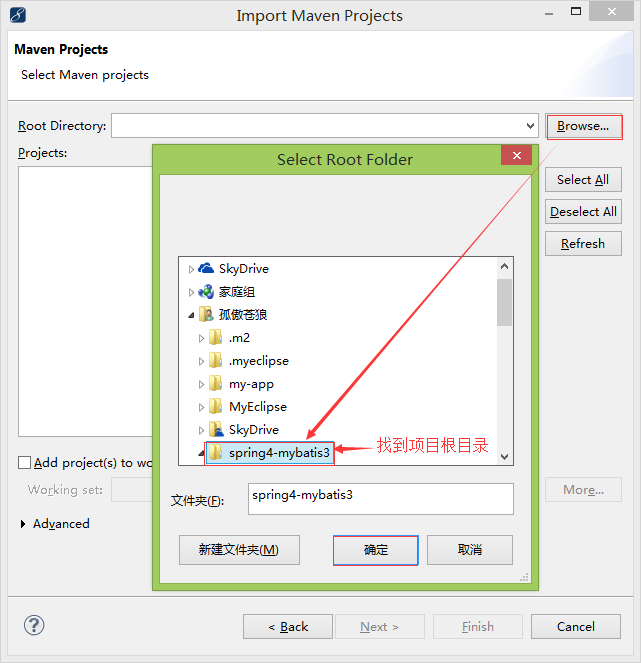
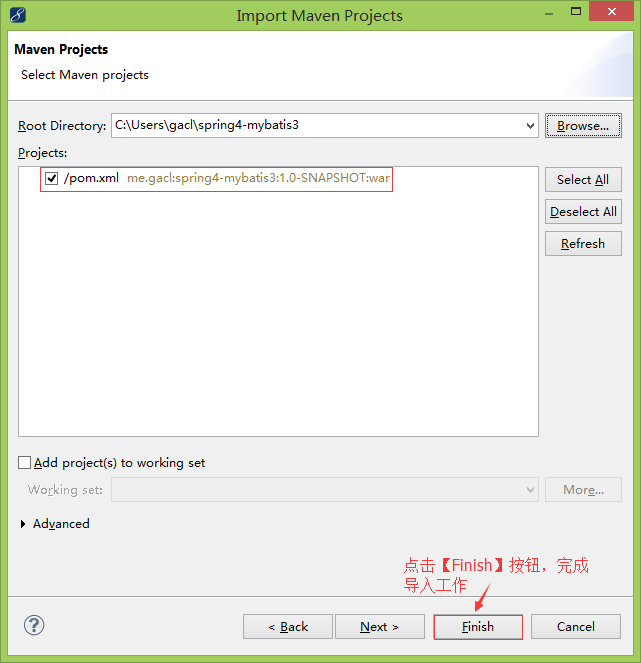

手動創建【src/main/java】、【src/test/resources】、【src/test/java】這三個source folder,如下圖所示:

到此,項目搭建的工作就算是全部完成了。
二、創建數據庫和表(針對MySQL)
SQL腳本如下:
|
1
2
3
4
5
6
7
8
9
10
|
Create DATABASE spring4_mybatis3;USE spring4_mybatis3;DROP TABLE IF EXISTS t_user;CREATE TABLE t_user ( user_id char(32) NOT NULL, user_name varchar(30) DEFAULT NULL, user_birthday date DEFAULT NULL, user_salary double DEFAULT NULL, PRIMARY KEY (user_id)) ENGINE=InnoDB DEFAULT CHARSET=utf8; |
創建好的數據庫和表如下:

三、使用generator工具生成代碼
在網上找到了一個generator工具可以根據創建好的數據庫表生成MyBatis的表對應的實體類,SQL映射文件和dao,找到generator工具根目錄下的generator.xml文件,這個文件是用來配置代碼生成規則的,如下圖所示:

編輯generator.xml文件,內容如下:
|
1
2
3
4
5
6
7
8
9
10
11
12
13
14
15
16
17
18
19
20
21
22
23
24
25
26
27
28
29
30
31
32
33
34
|
<?xml version="." encoding="UTF-"?> <!DOCTYPE generatorConfiguration PUBLIC "-//mybatis.org//DTD MyBatis Generator Configuration .//EN" "http://mybatis.org/dtd/mybatis-generator-config__.dtd"> <generatorConfiguration> <!-- 數據庫驅動包位置 --> <classPathEntry location="E:\repository\mysql\mysql-connector-java\..\mysql-connector-java-...jar" /> <!-- <classPathEntry location="C:\oracle\product\..\db_\jdbc\lib\ojdbc.jar" />--> <context id="DBTables" targetRuntime="MyBatis"> <commentGenerator> <property name="suppressAllComments" value="true" /> </commentGenerator> <!-- 數據庫鏈接URL、用戶名、密碼 --> <jdbcConnection driverClass="com.mysql.jdbc.Driver" connectionURL="jdbc:mysql://localhost:/spring_mybatis" userId="root" password="XDP"> <!--<jdbcConnection driverClass="oracle.jdbc.driver.OracleDriver" connectionURL="jdbc:oracle:thin:@localhost::orcl" userId="msa" password="msa">--> </jdbcConnection> <javaTypeResolver> <property name="forceBigDecimals" value="false" /> </javaTypeResolver> <!-- 生成實體類的包名和位置,這里配置將生成的實體類放在me.gacl.domain這個包下 --> <javaModelGenerator targetPackage="me.gacl.domain" targetProject="C:\Users\gacl\spring-mybatis\src\main\java"> <property name="enableSubPackages" value="true" /> <property name="trimStrings" value="true" /> </javaModelGenerator> <!-- 生成的SQL映射文件包名和位置,這里配置將生成的SQL映射文件放在me.gacl.mapping這個包下 --> <sqlMapGenerator targetPackage="me.gacl.mapping" targetProject="C:\Users\gacl\spring-mybatis\src\main\java"> <property name="enableSubPackages" value="true" /> </sqlMapGenerator> <!-- 生成DAO的包名和位置,這里配置將生成的dao類放在me.gacl.dao這個包下 --> <javaClientGenerator type="XMLMAPPER" targetPackage="me.gacl.dao" targetProject="C:\Users\gacl\spring-mybatis\src\main\java"> <property name="enableSubPackages" value="true" /> </javaClientGenerator> <!-- 要生成那些表(更改tableName和domainObjectName就可以) --> <table tableName="t_user" domainObjectName="User" enableCountByExample="false" enableUpdateByExample="false" enableDeleteByExample="false" enableSelectByExample="false" selectByExampleQueryId="false" /> </context> </generatorConfiguration> |
打開命令行窗口,切換到生成工具的根目錄下,執行如下命令:
|
1
|
java -jar mybatis-generator-core-1.3.2.jar -configfile generator.xml -overwrite |
如下圖所示:

剛才我們在generator.xml文件中配置將生成的代碼和SQL映射文件放到"C:\Users\gacl\spring4-mybatis3\src\main\java"這個目錄下,這個目錄就是我們的spring4-mybatis3項目所在目錄,我們刷新一下src/main/java目錄,就可以看到生成的代碼和映射文件了,如下圖所示:

生成的代碼和映射文件一行都不用改,可以直接應用到項目當中。下面我們看一眼由generator工具生成的代碼和映射文件:
1、生成的dao類
|
1
2
3
4
5
6
7
8
9
10
|
package me.gacl.dao;import me.gacl.domain.User;public interface UserMapper {int deleteByPrimaryKey(String userId);int insert(User record);int insertSelective(User record);User selectByPrimaryKey(String userId);int updateByPrimaryKeySelective(User record);int updateByPrimaryKey(User record);} |
生成的UserMapper是一個接口,里面定義了一些操作t_user表的增刪改查方法。
2、生成的實體類
|
1
2
3
4
5
6
7
8
9
10
11
12
13
14
15
16
17
18
19
20
21
22
23
24
25
26
27
28
29
30
31
32
|
package me.gacl.domain; import java.util.Date; public class User { private String userId; private String userName; private Date userBirthday; private Double userSalary; public String getUserId() { return userId; } public void setUserId(String userId) { this.userId = userId == null ? null : userId.trim(); } public String getUserName() { return userName; } public void setUserName(String userName) { this.userName = userName == null ? null : userName.trim(); } public Date getUserBirthday() { return userBirthday; } public void setUserBirthday(Date userBirthday) { this.userBirthday = userBirthday; } public Double getUserSalary() { return userSalary; } public void setUserSalary(Double userSalary) { this.userSalary = userSalary; } } |
User類是t_user表的對應的實體類,User類中定義的屬性和t_user表中的字段一一對應。
3、生成的SQL映射文件
|
1
2
3
4
5
6
7
8
9
10
11
12
13
14
15
16
17
18
19
20
21
22
23
24
25
26
27
28
29
30
31
32
33
34
35
36
37
38
39
40
41
42
43
44
45
46
47
48
49
50
51
52
53
54
55
56
57
58
59
60
61
62
63
64
65
66
67
68
69
70
71
72
73
74
75
76
77
78
79
80
81
82
|
<?xml version="." encoding="UTF-" ?> <!DOCTYPE mapper PUBLIC "-//mybatis.org//DTD Mapper .//EN" "http://mybatis.org/dtd/mybatis--mapper.dtd" > <mapper namespace="me.gacl.dao.UserMapper" > <resultMap id="BaseResultMap" type="me.gacl.domain.User" > <id column="user_id" property="userId" jdbcType="CHAR" /> <result column="user_name" property="userName" jdbcType="VARCHAR" /> <result column="user_birthday" property="userBirthday" jdbcType="DATE" /> <result column="user_salary" property="userSalary" jdbcType="DOUBLE" /> </resultMap> <sql id="Base_Column_List" > user_id, user_name, user_birthday, user_salary </sql> <select id="selectByPrimaryKey" resultMap="BaseResultMap" parameterType="java.lang.String" > select <include refid="Base_Column_List" /> from t_user where user_id = #{userId,jdbcType=CHAR} </select> <delete id="deleteByPrimaryKey" parameterType="java.lang.String" > delete from t_user where user_id = #{userId,jdbcType=CHAR} </delete> <insert id="insert" parameterType="me.gacl.domain.User" > insert into t_user (user_id, user_name, user_birthday, user_salary) values (#{userId,jdbcType=CHAR}, #{userName,jdbcType=VARCHAR}, #{userBirthday,jdbcType=DATE}, #{userSalary,jdbcType=DOUBLE}) </insert> <insert id="insertSelective" parameterType="me.gacl.domain.User" > insert into t_user <trim prefix="(" suffix=")" suffixOverrides="," > <if test="userId != null" > user_id, </if> <if test="userName != null" > user_name, </if> <if test="userBirthday != null" > user_birthday, </if> <if test="userSalary != null" > user_salary, </if> </trim> <trim prefix="values (" suffix=")" suffixOverrides="," > <if test="userId != null" > #{userId,jdbcType=CHAR}, </if> <if test="userName != null" > #{userName,jdbcType=VARCHAR}, </if> <if test="userBirthday != null" > #{userBirthday,jdbcType=DATE}, </if> <if test="userSalary != null" > #{userSalary,jdbcType=DOUBLE}, </if> </trim> </insert> <update id="updateByPrimaryKeySelective" parameterType="me.gacl.domain.User" > update t_user <set > <if test="userName != null" > user_name = #{userName,jdbcType=VARCHAR}, </if> <if test="userBirthday != null" > user_birthday = #{userBirthday,jdbcType=DATE}, </if> <if test="userSalary != null" > user_salary = #{userSalary,jdbcType=DOUBLE}, </if> </set> where user_id = #{userId,jdbcType=CHAR} </update> <update id="updateByPrimaryKey" parameterType="me.gacl.domain.User" > update t_user set user_name = #{userName,jdbcType=VARCHAR}, user_birthday = #{userBirthday,jdbcType=DATE}, user_salary = #{userSalary,jdbcType=DOUBLE} where user_id = #{userId,jdbcType=CHAR} </update> </mapper> |
UserMapper.xml這個文件的內容是編寫操作t_user表的SQL語句,重點說一下UserMapper.xml配置中需要注意的幾個小細節問題:
1、UserMapper.xml的<mapper>標簽的namespace必須是UserMapper接口的全類名,既<mapper namespace="me.gacl.dao.UserMapper" >
2、UserMapper.xml的定義操作數據庫的<select><delete><update><insert>這些標簽的id屬性的值必須和UserMapper接口定義的方法名一致,如下圖所示:

之所以有上述說的這兩點要求,就是為了能夠讓MyBatis能夠根據UserMapper接口和UserMapper.xml文件去自動實現UserMapper接口中定義的相關方法,這樣我們就不再需要針對UserMapper接口去編寫具體的實現代碼了。
四、Spring與MyBatis整合
首先我們要在項目中加入我們需要的相關jar包,我們可以到Maven的中央倉庫:http://search.maven.org/找到我們要的相關jar包,如下圖所示:

我們只需要在搜索框中輸入要找的jar包的名稱,點擊【SEARCH】按鈕,就可以找到我們要的jar包了。
4.1、添加Spring與Mybatis的相關jar包
1、添加spring-core,輸入spring-core關鍵字進行查找,如下圖所示:
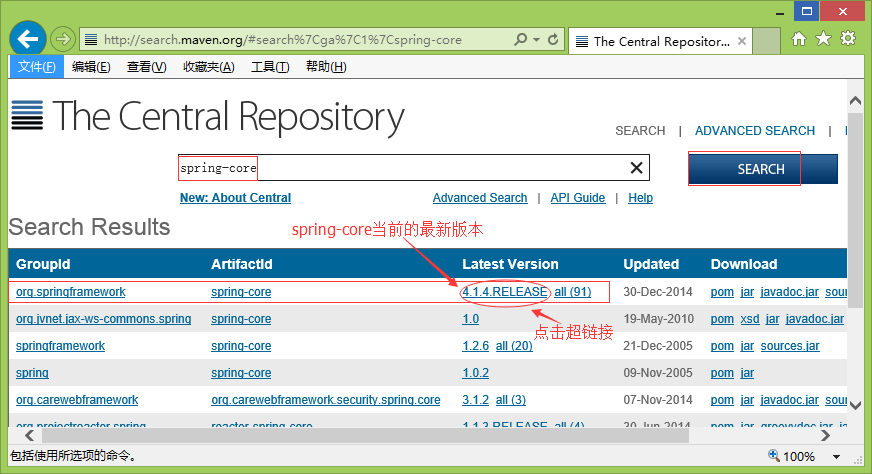
找到關于spring-core的依賴描述信息,如下圖所示:
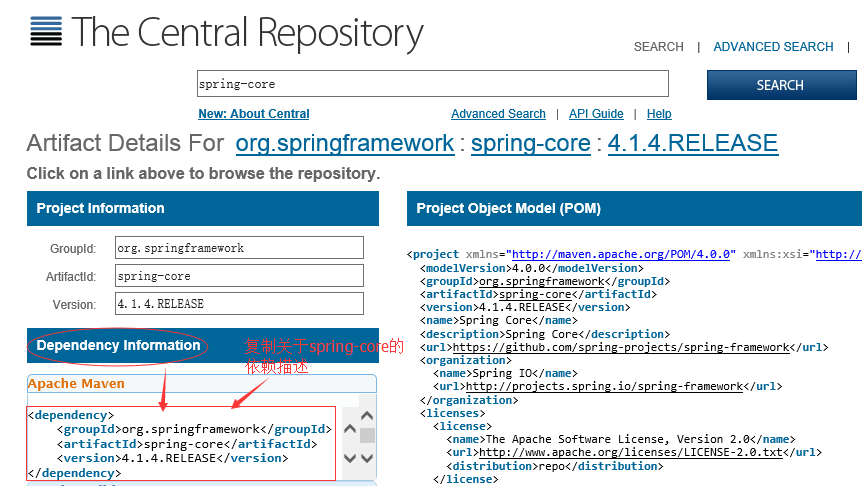
將
|
1
2
3
4
5
|
<dependency> <groupId>org.springframework</groupId> <artifactId>spring-core</artifactId> <version>4.1.4.RELEASE</version></dependency> |
復制到項目的pom.xml文件中,如下所示:
|
1
2
3
4
5
6
7
8
9
10
11
12
13
14
15
16
17
18
19
20
21
|
<project xmlns="http://maven.apache.org/POM/4.0.0" xmlns:xsi="http://www.w3.org/2001/XMLSchema-instance" xsi:schemaLocation="http://maven.apache.org/POM/4.0.0 http://maven.apache.org/maven-v4_0_0.xsd"> <modelVersion>4.0.0</modelVersion> <groupId>me.gacl</groupId> <artifactId>spring4-mybatis3</artifactId> <packaging>war</packaging> <version>1.0-SNAPSHOT</version> <name>spring4-mybatis3</name> <url>http://maven.apache.org</url> <dependencies> <!-- 添加Spring4.1.4的核心包 --> <dependency> <groupId>org.springframework</groupId> <artifactId>spring-core</artifactId> <version>4.1.4.RELEASE</version> </dependency> </dependencies> <build> <finalName>spring4-mybatis3</finalName> </build></project> |
這樣Maven就會自動幫我們從Maven的中央倉庫中下載spring-core這個jar包到我們的本地倉庫,然后將spring-core這個jar包以及它的相關依賴包加入到我們的項目當中,如下所示:
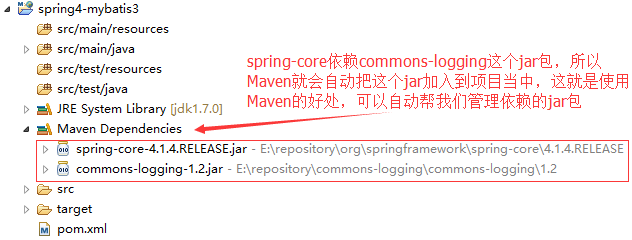
spring4.x與mybatis3.x所需要的相關jar包都可以采用上述所說的方式進行查找,然后添加到項目當中,添加完spring4.x與mybatis3.x相關jar包后,pom.xml文件內容最終如下:
|
1
2
3
4
5
6
7
8
9
10
11
12
13
14
15
16
17
18
19
20
21
22
23
24
25
26
27
28
29
30
31
32
33
34
35
36
37
38
39
40
41
42
43
44
45
46
47
48
49
50
51
52
53
54
55
56
57
58
59
60
61
62
63
64
65
66
67
68
69
70
71
72
73
74
75
76
77
78
79
80
81
82
83
84
85
86
87
88
89
90
91
92
93
94
95
96
97
98
99
100
101
102
103
104
105
|
<project xmlns="http://maven.apache.org/POM/.." xmlns:xsi="http://www.w.org//XMLSchema-instance" xsi:schemaLocation="http://maven.apache.org/POM/.. http://maven.apache.org/maven-v__.xsd"> <modelVersion>..</modelVersion> <groupId>me.gacl</groupId> <artifactId>spring-mybatis</artifactId> <packaging>war</packaging> <version>.-SNAPSHOT</version> <name>spring-mybatis</name> <url>http://maven.apache.org</url> <dependencies> <!-- 添加Spring-core包 --> <dependency> <groupId>org.springframework</groupId> <artifactId>spring-core</artifactId> <version>...RELEASE</version> </dependency> <!-- 添加spring-context包 --> <dependency> <groupId>org.springframework</groupId> <artifactId>spring-context</artifactId> <version>...RELEASE</version> </dependency> <!-- 添加spring-tx包 --> <dependency> <groupId>org.springframework</groupId> <artifactId>spring-tx</artifactId> <version>...RELEASE</version> </dependency> <!-- 添加spring-jdbc包 --> <dependency> <groupId>org.springframework</groupId> <artifactId>spring-jdbc</artifactId> <version>...RELEASE</version> </dependency> <!-- 為了方便進行單元測試,添加spring-test包 --> <dependency> <groupId>org.springframework</groupId> <artifactId>spring-test</artifactId> <version>...RELEASE</version> </dependency> <!--添加spring-web包 --> <dependency> <groupId>org.springframework</groupId> <artifactId>spring-web</artifactId> <version>...RELEASE</version> </dependency> <!--添加aspectjweaver包 --> <dependency> <groupId>org.aspectj</groupId> <artifactId>aspectjweaver</artifactId> <version>..</version> </dependency> <!-- 添加mybatis的核心包 --> <dependency> <groupId>org.mybatis</groupId> <artifactId>mybatis</artifactId> <version>..</version> </dependency> <!-- 添加mybatis與Spring整合的核心包 --> <dependency> <groupId>org.mybatis</groupId> <artifactId>mybatis-spring</artifactId> <version>..</version> </dependency> <!-- 添加servlet.核心包 --> <dependency> <groupId>javax.servlet</groupId> <artifactId>javax.servlet-api</artifactId> <version>..</version> </dependency> <dependency> <groupId>javax.servlet.jsp</groupId> <artifactId>javax.servlet.jsp-api</artifactId> <version>..-b</version> </dependency> <!-- jstl --> <dependency> <groupId>javax.servlet</groupId> <artifactId>jstl</artifactId> <version>.</version> </dependency> <!-- 添加mysql驅動包 --> <dependency> <groupId>mysql</groupId> <artifactId>mysql-connector-java</artifactId> <version>..</version> </dependency> <!-- 添加druid連接池包 --> <dependency> <groupId>com.alibaba</groupId> <artifactId>druid</artifactId> <version>..</version> </dependency> <!-- 添加junit單元測試包 --> <dependency> <groupId>junit</groupId> <artifactId>junit</artifactId> <version>.</version> <scope>test</scope> </dependency> </dependencies> <build> <finalName>spring-mybatis</finalName> </build> </project> |

4.2、編寫相關配置文件
1、dbconfig.properties
在src/main/resources目錄下創建一個dbconfig.properties文件,用于編寫連接MySQL數據庫的相關信息,dbconfig.properties的內容如下:
|
1
2
3
4
5
|
driverClassName=com.mysql.jdbc.DrivervalidationQuery=SELECT 1jdbc_url=jdbc:mysql://localhost:3306/spring4_mybatis3?useUnicode=true&characterEncoding=UTF-8&zeroDateTimeBehavior=convertToNulljdbc_username=rootjdbc_password=XDP |
2、spring.xml(spring框架的配置文件)
在src/main/resources目錄下創建一個spring.xml文件,spring.xml文件就是針對Spring框架編寫的核心配置文件,spring.xml的內容如下:
|
1
2
3
4
5
6
7
8
9
10
11
12
13
|
<?xml version="1.0" encoding="UTF-8"?><beans xmlns="http://www.springframework.org/schema/beans" xmlns:xsi="http://www.w3.org/2001/XMLSchema-instance" xmlns:context="http://www.springframework.org/schema/context" xsi:schemaLocation="http://www.springframework.org/schema/beanshttp://www.springframework.org/schema/beans/spring-beans-3.0.xsdhttp://www.springframework.org/schema/contexthttp://www.springframework.org/schema/context/spring-context-3.0.xsd"> <!-- 引入dbconfig.properties屬性文件 --> <context:property-placeholder location="classpath:dbconfig.properties" /> <!-- 自動掃描(自動注入),掃描me.gacl.service這個包以及它的子包的所有使用@Service注解標注的類 --> <context:component-scan base-package="me.gacl.service" /></beans> |
我們的spring.xml文件的配置非常簡單,就兩個配置。
3、spring-mybatis.xml(spring與mybatis整合的配置文件)
在src/main/resources目錄下創建一個spring-mybatis.xml文件,spring-mybatis.xml文件就是針對Spring框架與Mybatis框架整合編寫的配置文件,spring-mybatis.xml的內容如下:
|
1
2
3
4
5
6
7
8
9
10
11
12
13
14
15
16
17
18
19
20
21
22
23
24
25
26
27
28
29
30
31
32
33
34
35
36
37
38
39
40
41
42
43
44
45
46
47
48
49
50
51
52
53
54
55
56
57
58
59
60
61
62
63
64
65
66
67
68
69
70
71
72
73
74
75
76
77
78
79
80
81
82
83
84
85
86
87
88
89
90
91
92
93
94
95
96
97
98
99
100
101
102
103
104
105
106
107
108
109
110
111
112
113
114
|
<?xml version="1.0" encoding="UTF-8"?><beans xmlns="http://www.springframework.org/schema/beans" xmlns:xsi="http://www.w3.org/2001/XMLSchema-instance" xmlns:tx="http://www.springframework.org/schema/tx" xmlns:aop="http://www.springframework.org/schema/aop" xsi:schemaLocation="http://www.springframework.org/schema/beans http://www.springframework.org/schema/beans/spring-beans-3.0.xsd http://www.springframework.org/schema/tx http://www.springframework.org/schema/tx/spring-tx-3.0.xsdhttp://www.springframework.org/schema/aop http://www.springframework.org/schema/aop/spring-aop-3.0.xsd"> <!-- JNDI方式配置數據源 --> <!-- <bean id="dataSource" class="org.springframework.jndi.JndiObjectFactoryBean"> <property name="jndiName" value="${jndiName}"></property> </bean> --> <!-- ========================================配置數據源========================================= --> <!-- 配置數據源,使用的是alibaba的Druid(德魯伊)數據源 --> <bean name="dataSource" class="com.alibaba.druid.pool.DruidDataSource" init-method="init" destroy-method="close"> <property name="url" value="${jdbc_url}" /> <property name="username" value="${jdbc_username}" /> <property name="password" value="${jdbc_password}" /> <!-- 初始化連接大小 --> <property name="initialSize" value="0" /> <!-- 連接池最大使用連接數量 --> <property name="maxActive" value="20" /> <!-- 連接池最大空閑 --> <property name="maxIdle" value="20" /> <!-- 連接池最小空閑 --> <property name="minIdle" value="0" /> <!-- 獲取連接最大等待時間 --> <property name="maxWait" value="60000" /> <!-- <property name="poolPreparedStatements" value="true" /> <property name="maxPoolPreparedStatementPerConnectionSize" value="33" /> --> <property name="validationQuery" value="${validationQuery}" /> <property name="testOnBorrow" value="false" /> <property name="testOnReturn" value="false" /> <property name="testWhileIdle" value="true" /> <!-- 配置間隔多久才進行一次檢測,檢測需要關閉的空閑連接,單位是毫秒 --> <property name="timeBetweenEvictionRunsMillis" value="60000" /> <!-- 配置一個連接在池中最小生存的時間,單位是毫秒 --> <property name="minEvictableIdleTimeMillis" value="25200000" /> <!-- 打開removeAbandoned功能 --> <property name="removeAbandoned" value="true" /> <!-- 1800秒,也就是30分鐘 --> <property name="removeAbandonedTimeout" value="1800" /> <!-- 關閉abanded連接時輸出錯誤日志 --> <property name="logAbandoned" value="true" /> <!-- 監控數據庫 --> <!-- <property name="filters" value="stat" /> --> <property name="filters" value="mergeStat" /> </bean> <!-- ========================================分隔線========================================= --> <!-- ========================================針對myBatis的配置項============================== --> <!-- 配置sqlSessionFactory --> <bean id="sqlSessionFactory" class="org.mybatis.spring.SqlSessionFactoryBean"> <!-- 實例化sqlSessionFactory時需要使用上述配置好的數據源以及SQL映射文件 --> <property name="dataSource" ref="dataSource" /> <!-- 自動掃描me/gacl/mapping/目錄下的所有SQL映射的xml文件, 省掉Configuration.xml里的手工配置 value="classpath:me/gacl/mapping/*.xml"指的是classpath(類路徑)下me.gacl.mapping包中的所有xml文件 UserMapper.xml位于me.gacl.mapping包下,這樣UserMapper.xml就可以被自動掃描 --> <property name="mapperLocations" value="classpath:me/gacl/mapping/*.xml" /> </bean> <!-- 配置掃描器 --> <bean class="org.mybatis.spring.mapper.MapperScannerConfigurer"> <!-- 掃描me.gacl.dao這個包以及它的子包下的所有映射接口類 --> <property name="basePackage" value="me.gacl.dao" /> <property name="sqlSessionFactoryBeanName" value="sqlSessionFactory" /> </bean> <!-- ========================================分隔線========================================= --> <!-- 配置Spring的事務管理器 --> <bean id="transactionManager" class="org.springframework.jdbc.datasource.DataSourceTransactionManager"> <property name="dataSource" ref="dataSource" /> </bean> <!-- 注解方式配置事物 --> <!-- <tx:annotation-driven transaction-manager="transactionManager" /> --> <!-- 攔截器方式配置事物 --> <tx:advice id="transactionAdvice" transaction-manager="transactionManager"> <tx:attributes> <tx:method name="add*" propagation="REQUIRED" /> <tx:method name="append*" propagation="REQUIRED" /> <tx:method name="insert*" propagation="REQUIRED" /> <tx:method name="save*" propagation="REQUIRED" /> <tx:method name="update*" propagation="REQUIRED" /> <tx:method name="modify*" propagation="REQUIRED" /> <tx:method name="edit*" propagation="REQUIRED" /> <tx:method name="delete*" propagation="REQUIRED" /> <tx:method name="remove*" propagation="REQUIRED" /> <tx:method name="repair" propagation="REQUIRED" /> <tx:method name="delAndRepair" propagation="REQUIRED" /> <tx:method name="get*" propagation="SUPPORTS" /> <tx:method name="find*" propagation="SUPPORTS" /> <tx:method name="load*" propagation="SUPPORTS" /> <tx:method name="search*" propagation="SUPPORTS" /> <tx:method name="datagrid*" propagation="SUPPORTS" /> <tx:method name="*" propagation="SUPPORTS" /> </tx:attributes> </tx:advice> <aop:config> <aop:pointcut id="transactionPointcut" expression="execution(* me.gacl.service..*Impl.*(..))" /> <aop:advisor pointcut-ref="transactionPointcut" advice-ref="transactionAdvice" /> </aop:config> <!-- 配置druid監控spring jdbc --> <bean id="druid-stat-interceptor" class="com.alibaba.druid.support.spring.stat.DruidStatInterceptor"> </bean> <bean id="druid-stat-pointcut" class="org.springframework.aop.support.JdkRegexpMethodPointcut" scope="prototype"> <property name="patterns"> <list> <value>me.gacl.service.*</value> </list> </property> </bean> <aop:config> <aop:advisor advice-ref="druid-stat-interceptor" pointcut-ref="druid-stat-pointcut" /> </aop:config></beans> |
到此,相關的配置文件算是編寫完成了,如下圖所示:
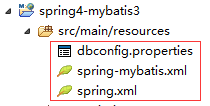
4.3、進行單元測試
經過以上兩個步驟,spring4與mybatis3的整合算是全部完成了。接下來我們要做的工作就算進行單元測試,測試一下spring4與mybatis3的整合是否成功。
1、在src/main/java目錄下創建一個me.gacl.service包,然后在me.gacl.service包創建一個UserServiceI接口,如下所示:
|
1
2
3
4
5
6
7
8
9
10
11
12
13
14
15
|
package me.gacl.service; import me.gacl.domain.User; public interface UserServiceI { /** * 添加用戶 * @param user */ void addUser(User user); /** * 根據用戶id獲取用戶 * @param userId * @return */ User getUserById(String userId); } |
2、在src/main/java目錄下創建一個me.gacl.service.impl包,然后在me.gacl.service.impl包創建一個針對UserServiceI接口的實現類:UserServiceImpl,如下所示:
|
1
2
3
4
5
6
7
8
9
10
11
12
13
14
15
16
17
18
19
20
21
22
23
24
25
26
27
28
|
package me.gacl.service.impl; import org.springframework.beans.factory.annotation.Autowired; import org.springframework.stereotype.Service; import me.gacl.dao.UserMapper; import me.gacl.domain.User; import me.gacl.service.UserServiceI; /** * @author gacl * 使用@Service注解將UserServiceImpl類標注為一個service * service的id是userService */ @Service("userService") public class UserServiceImpl implements UserServiceI { /** * 使用@Autowired注解標注userMapper變量, * 當需要使用UserMapper時,Spring就會自動注入UserMapper */ @Autowired private UserMapper userMapper;//注入dao @Override public void addUser(User user) { userMapper.insert(user); } @Override public User getUserById(String userId) { return userMapper.selectByPrimaryKey(userId); } } |
創建好的兩個類如下所示:
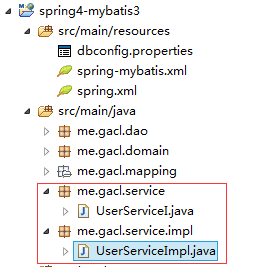
3、在src/test/java目錄下編寫單元測試類,新建一個me.gacl.test包,然后在這個包下創建一個MyBatisTest類,代碼如下:
|
1
2
3
4
5
6
7
8
9
10
11
12
13
14
15
16
17
18
19
20
21
22
23
24
25
26
27
28
29
30
31
32
33
34
35
36
|
package me.gacl.test;import java.util.Date;import java.util.UUID;import me.gacl.domain.User;import me.gacl.service.UserServiceI;//import me.gacl.service.UserServiceI;import org.junit.Before;import org.junit.Test;import org.springframework.context.ApplicationContext;import org.springframework.context.support.ClassPathXmlApplicationContext;public class MyBatisTest {private UserServiceI userService;/*** 這個before方法在所有的測試方法之前執行,并且只執行一次* 所有做Junit單元測試時一些初始化工作可以在這個方法里面進行* 比如在before方法里面初始化ApplicationContext和userService*/@Beforepublic void before(){ //使用"spring.xml"和"spring-mybatis.xml"這兩個配置文件創建Spring上下文 ApplicationContext ac = new ClassPathXmlApplicationContext(new String[]{"spring.xml","spring-mybatis.xml"}); //從Spring容器中根據bean的id取出我們要使用的userService對象 userService = (UserServiceI) ac.getBean("userService");}@Testpublic void testAddUser(){ //ApplicationContext ac = new ClassPathXmlApplicationContext(new String[]{"spring.xml","spring-mybatis.xml"}); //UserServiceI userService = (UserServiceI) ac.getBean("userService"); User user = new User(); user.setUserId(UUID.randomUUID().toString().replaceAll("-", "")); user.setUserName("白虎神皇xdp"); user.setUserBirthday(new Date()); user.setUserSalary(D); userService.addUser(user);}} |
執行單元測試代碼,這時候會報如下錯誤:

錯誤提示是說沒有找到"me.gacl.test.MyBatisTest"這個類,這是因為我們沒有使用maven編譯項目中的類的緣故。
下面我們使用Maven編譯項目,選中項目的pom.xml文件→【Debug As】→【maven install】,如下所示:

編譯結果如下:

在這里說一下我執行Maven install之后遇到的問題,第一次執行Maven install命令時,就出現了如下一堆亂七八糟的錯誤:

后來我把項目刪掉,再重新導入項目,然后再執行Clean項目操作之后,如下圖所示:

再執行Maven install操作又可以正常編譯通過了,這讓我郁悶了好久,這應該不是我項目配置的原因,而是Maven的原因,具體也不知道為啥會這樣。反正這算是一種解決辦法吧,如果遇到執行Maven install操作不能正常編譯通過的情況:可以嘗試采用:Maven clean→Clean項目→Maven install這三個步驟去解決問題。
除了可以用常規的Junit進行單元測試之外,我們還可以使用Spring提供的Junit測試框架進行單元測試,在me.gacl.test下新建一個MyBatisTestBySpringTestFramework類,代碼如下:
|
1
2
3
4
5
6
7
8
9
10
11
12
13
14
15
16
17
18
19
20
21
22
23
24
25
26
27
28
29
30
31
32
33
|
package me.gacl.test; import java.util.Date; import java.util.UUID; import me.gacl.domain.User; import me.gacl.service.UserServiceI; import org.junit.Test; import org.junit.runner.RunWith; import org.springframework.beans.factory.annotation.Autowired; import org.springframework.test.context.ContextConfiguration; import org.springframework.test.context.junit.SpringJUnitClassRunner; @RunWith(SpringJUnitClassRunner.class) //配置了@ContextConfiguration注解并使用該注解的locations屬性指明spring和配置文件之后, @ContextConfiguration(locations = {"classpath:spring.xml", "classpath:spring-mybatis.xml" }) public class MyBatisTestBySpringTestFramework { //注入userService @Autowired private UserServiceI userService; @Test public void testAddUser(){ User user = new User(); user.setUserId(UUID.randomUUID().toString().replaceAll("-", "")); user.setUserName("xdp_gacl_白虎神皇"); user.setUserBirthday(new Date()); user.setUserSalary(D); userService.addUser(user); } @Test public void testGetUserById(){ String userId = "fbcebfdada"; User user = userService.getUserById(userId); System.out.println(user.getUserName()); } } |
執行這兩個測試方法,是可以正常測試通過的,如下所示:


到此,我們框架的整合測試工作就算是全部通過了,整合成功。
4.4、在web服務器中進行測試
1、編輯web.xml文件,添加spring監聽器配置項,內容如下:
|
1
2
3
4
5
6
7
8
9
10
11
12
13
14
15
16
17
18
19
|
<?xml version="1.0" encoding="UTF-8"?><web-app xmlns="http://java.sun.com/xml/ns/javaee" xmlns:xsi="http://www.w3.org/2001/XMLSchema-instance" xsi:schemaLocation="http://java.sun.com/xml/ns/javaee http://java.sun.com/xml/ns/javaee/web-app_3_0.xsd" version="3.0"> <welcome-file-list> <welcome-file>index.jsp</welcome-file> </welcome-file-list> <listener> <description>Spring監聽器</description> <listener-class>org.springframework.web.context.ContextLoaderListener</listener-class> </listener> <!-- ContextLoaderListener初始化Spring上下文時需要使用到的contextConfigLocation參數 --> <context-param> <param-name>contextConfigLocation</param-name> <!-- 配置spring.xml和spring-mybatis.xml這兩個配置文件的位置,固定寫法 --> <param-value>classpath:spring.xml,classpath:spring-mybatis.xml</param-value> </context-param></web-app> |
2、在UserMapper接口中添加一個獲取所有用戶信息的getAllUser()方法,如下所示:
|
1
2
3
4
5
6
7
8
9
10
11
12
13
14
15
|
package me.gacl.dao;import java.util.List;import me.gacl.domain.User;public interface UserMapper {int deleteByPrimaryKey(String userId);int insert(User record);int insertSelective(User record);User selectByPrimaryKey(String userId);int updateByPrimaryKeySelective(User record);int updateByPrimaryKey(User record);/**獲取所有用戶信息* @return List<User>*/List<User> getAllUser();} |
3、在UserMapper.xml文件中編寫getAllUser()方法要執行的SQL語句,如下所示:
|
1
2
3
4
5
6
7
8
9
10
11
12
13
14
15
16
17
18
19
20
21
22
23
24
25
26
27
28
29
30
31
32
33
34
35
36
37
38
39
40
41
42
43
44
45
46
47
48
49
50
51
52
53
54
55
56
57
58
59
60
61
62
63
64
65
66
67
68
69
70
71
72
73
74
75
76
77
78
79
80
81
82
83
84
85
86
87
|
<?xml version="1.0" encoding="UTF-8" ?><!DOCTYPE mapper PUBLIC "-//mybatis.org//DTD Mapper 3.0//EN" "http://mybatis.org/dtd/mybatis-3-mapper.dtd" ><mapper namespace="me.gacl.dao.UserMapper" > <resultMap id="BaseResultMap" type="me.gacl.domain.User" > <id column="user_id" property="userId" jdbcType="CHAR" /> <result column="user_name" property="userName" jdbcType="VARCHAR" /> <result column="user_birthday" property="userBirthday" jdbcType="DATE" /> <result column="user_salary" property="userSalary" jdbcType="DOUBLE" /> </resultMap> <sql id="Base_Column_List" > user_id, user_name, user_birthday, user_salary </sql> <select id="selectByPrimaryKey" resultMap="BaseResultMap" parameterType="java.lang.String" > select <include refid="Base_Column_List" /> from t_user where user_id = #{userId,jdbcType=CHAR} </select> <delete id="deleteByPrimaryKey" parameterType="java.lang.String" > delete from t_user where user_id = #{userId,jdbcType=CHAR} </delete> <insert id="insert" parameterType="me.gacl.domain.User" > insert into t_user (user_id, user_name, user_birthday, user_salary) values (#{userId,jdbcType=CHAR}, #{userName,jdbcType=VARCHAR}, #{userBirthday,jdbcType=DATE}, #{userSalary,jdbcType=DOUBLE}) </insert> <insert id="insertSelective" parameterType="me.gacl.domain.User" > insert into t_user <trim prefix="(" suffix=")" suffixOverrides="," > <if test="userId != null" > user_id, </if> <if test="userName != null" > user_name, </if> <if test="userBirthday != null" > user_birthday, </if> <if test="userSalary != null" > user_salary, </if> </trim> <trim prefix="values (" suffix=")" suffixOverrides="," > <if test="userId != null" > #{userId,jdbcType=CHAR}, </if> <if test="userName != null" > #{userName,jdbcType=VARCHAR}, </if> <if test="userBirthday != null" > #{userBirthday,jdbcType=DATE}, </if> <if test="userSalary != null" > #{userSalary,jdbcType=DOUBLE}, </if> </trim> </insert> <update id="updateByPrimaryKeySelective" parameterType="me.gacl.domain.User" > update t_user <set > <if test="userName != null" > user_name = #{userName,jdbcType=VARCHAR}, </if> <if test="userBirthday != null" > user_birthday = #{userBirthday,jdbcType=DATE}, </if> <if test="userSalary != null" > user_salary = #{userSalary,jdbcType=DOUBLE}, </if> </set> where user_id = #{userId,jdbcType=CHAR} </update> <update id="updateByPrimaryKey" parameterType="me.gacl.domain.User" > update t_user set user_name = #{userName,jdbcType=VARCHAR}, user_birthday = #{userBirthday,jdbcType=DATE}, user_salary = #{userSalary,jdbcType=DOUBLE} where user_id = #{userId,jdbcType=CHAR} </update> <!-- ==============以下內容是根據自身業務擴展的內容======================= --> <!-- select標簽的id屬性與UserMapper接口中定義的getAllUser方法要一模一樣 --> <select id="getAllUser" resultMap="BaseResultMap"> select user_id, user_name, user_birthday, user_salary from t_user </select></mapper> |
4、在UserServiceI接口中也添加一個getAllUser()方法,如下:
|
1
2
3
4
5
6
7
8
9
10
11
12
13
14
15
16
17
18
19
20
|
package me.gacl.service; import java.util.List; import me.gacl.domain.User; public interface UserServiceI { /** * 添加用戶 * @param user */ void addUser(User user); /** * 根據用戶id獲取用戶 * @param userId * @return */ User getUserById(String userId); /**獲取所有用戶信息 * @return List<User> */ List<User> getAllUser(); } |
5、在UserServiceImpl類中實現getAllUser方法,如下:
|
1
2
3
4
5
6
7
8
9
10
11
12
13
14
15
16
17
18
19
20
21
22
23
24
25
26
27
28
29
30
31
32
33
|
package me.gacl.service.impl;import java.util.List;import org.springframework.beans.factory.annotation.Autowired;import org.springframework.stereotype.Service;import me.gacl.dao.UserMapper;import me.gacl.domain.User;import me.gacl.service.UserServiceI;/*** @author gacl* 使用@Service注解將UserServiceImpl類標注為一個service* service的id是userService*/@Service("userService")public class UserServiceImpl implements UserServiceI {/*** 使用@Autowired注解標注userMapper變量,* 當需要使用UserMapper時,Spring就會自動注入UserMapper*/@Autowiredprivate UserMapper userMapper;//注入dao@Overridepublic void addUser(User user) { userMapper.insert(user);}@Overridepublic User getUserById(String userId) { return userMapper.selectByPrimaryKey(userId);}@Overridepublic List<User> getAllUser() { return userMapper.getAllUser();}} |
6、在src/main/java目錄下創建一個me.gacl.web.controller包,然后在me.gacl.web.controller下創建一個UserServlet,如下:
|
1
2
3
4
5
6
7
8
9
10
11
12
13
14
15
16
17
18
19
20
21
22
23
24
25
26
27
28
29
30
31
32
33
34
35
36
37
38
39
|
package me.gacl.web.controller;import java.io.IOException;import java.util.List;import javax.servlet.ServletException;import javax.servlet.annotation.WebServlet;import javax.servlet.http.HttpServlet;import javax.servlet.http.HttpServletRequest;import javax.servlet.http.HttpServletResponse;import org.springframework.context.ApplicationContext;import org.springframework.web.context.support.WebApplicationContextUtils;import me.gacl.domain.User;import me.gacl.service.UserServiceI;/*** @author gacl* @WebServlet是Servlet.提供的注解,目的是將一個繼承了HttpServlet類的普通java類標注為一個Servlet* UserServlet使用了@WebServlet標注之后,就不需要在web.xml中配置了*/@WebServlet("/UserServlet")public class UserServlet extends HttpServlet {//處理業務邏輯的userServiceprivate UserServiceI userService;public void doGet(HttpServletRequest request, HttpServletResponse response) throws ServletException, IOException { //獲取所有的用戶信息 List<User> lstUsers = userService.getAllUser(); request.setAttribute("lstUsers", lstUsers); request.getRequestDispatcher("/index.jsp").forward(request, response);}public void doPost(HttpServletRequest request, HttpServletResponse response) throws ServletException, IOException { this.doGet(request, response);}public void init() throws ServletException { //在Servlet初始化時獲取Spring上下文對象(ApplicationContext) ApplicationContext ac = WebApplicationContextUtils.getWebApplicationContext(this.getServletContext()); //從ApplicationContext中獲取userService userService = (UserServiceI) ac.getBean("userService");}} |
7、編輯index.jsp頁面,用于展示查詢到的用戶信息,內容如下:
|
1
2
3
4
5
6
7
8
9
10
11
12
13
14
15
16
17
18
19
20
21
22
23
24
25
26
27
28
29
30
31
32
33
34
|
<%@ page language="java" pageEncoding="UTF-8"%><%--引入JSTL核心標簽庫 --%><%@ taglib prefix="c" uri="http://java.sun.com/jsp/jstl/core"%><!DOCTYPE html><html> <head> <title>顯示用戶信息</title> <style type="text/css"> table,td{ border: 1px solid; border-collapse: collapse; } </style> </head> <body> <table> <tr> <td>用戶ID</td> <td>用戶名</td> <td>用戶生日</td> <td>工資</td> </tr> <%--遍歷lstUsers集合中的User對象 --%> <c:forEach var="user" items="${lstUsers}"> <tr> <td>${user.userId}</td> <td>${user.userName}</td> <td>${user.userBirthday}</td> <td>${user.userSalary}</td> </tr> </c:forEach> </table> </body></html> |
8、執行maven install命令編譯項目,然后將項目部署到tomcat服務器中運行,注意,由于要使用Servlet3.0,所以必須將項目部署到tomcat7.x以上的服務器中去運行,如下所示:

輸入地址:http://localhost:8080/spring4-mybatis3/UserServlet訪問UserServlet,訪問結果如下:
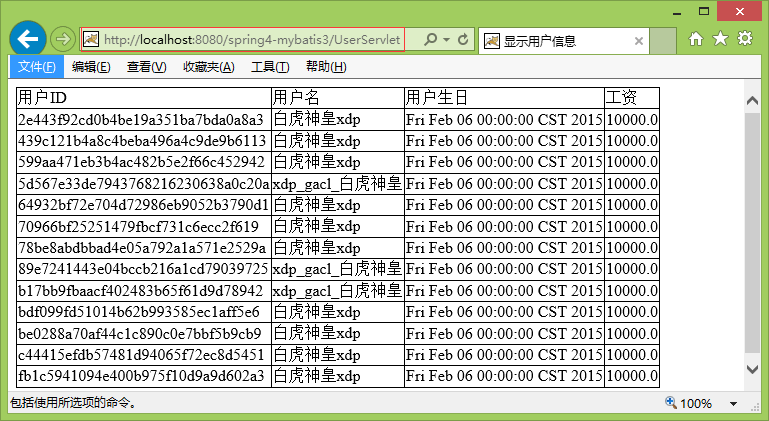
可以看到,t_user表中的用戶信息全部查詢出來顯示到頁面上了。這樣在web服務器中的測試也正常通過了。
以上就是Spring4.x與MyBatis3.x整合的全部內容了。編寫這個整合例子花了不少時間,使用Maven編譯時總是出現莫名其妙的問題,有時候成功,有時候失敗,反正很莫名其妙。如果遇到執行Maven install操作不能正常編譯通過的情況:可以嘗試采用:Maven clean→Clean項目→Maven install這三個步驟去解決問題















